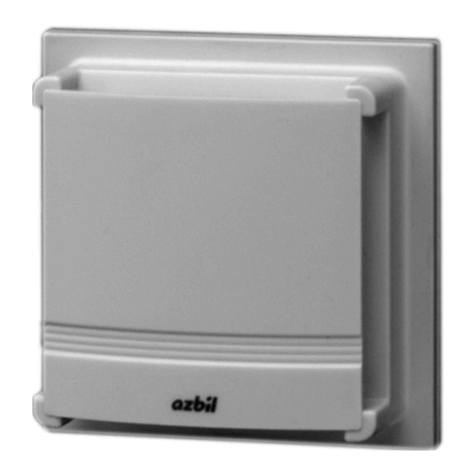
AB-5963
4
Specifications
Item Specification
Temperature -20 °C to 60 °CMeasurement range
Dewpoint temperature -40 °C to 60 °C DP (-20 °C to 60 °C) (non-condensing)
Temperature 100 Ω/ 0 °C
Models HTY79X3T1, HY79X3T1 series:
1 V DC to 5 V DC (linear to -40 °C to 60 °C DP)
(Input impedance of the controller connected: 10 kΩor higher)
Models HTY79X3T4, HY79X3T4 series:
4 mA DC to 20 mA DC (linear to -40 °C to 60 °C DP)
(Maximum allowable load: 300 Ωor lower)
Output signal
Dewpoint temperature
Models HTY79X3T6, HY79X3T6 series:
0 V DC to10 V DC (linear to -40 °C to 60 °C DP)
(Input impedance of the controller connected: 10 kΩor higher)
Temperature ±0.3 °C (at -20 °C to 60 °C) (Pt100 element)Sensing accuracy
Dewpoint temperature ±1 °C DP (at 30 %RH to 90 %RH, 25 °C)
±2.5 °C DP (at 30 %RH to 90 %RH, -5 °C to 60 °C)
Temperature 4 min. or lessTime constant
(at 2 m/s air velocity) Dewpoint temperature 1 min. or less (at constant temperature)
Rated/extreme operating conditions Transport/storage conditions
Temperature
range
-20 °C to 60 °C -30 °C to 70 °CTemperature
measuring
Humidity
range
0 %RH to 100 %RH
(non-condensing)
5 %RH to 95 %RH
(non-condensing)
Temperature
range
-20 °C to 60 °C -30 °C to 70 °C
Environmental
conditions
Dewpoint temperature
measuring
Humidity
range
Rated: 10 %RH to 100 %RH
Extreme: 0 %RH to 100 %RH
(non-condensing)
5 %RH to 95 %RH
(non-condensing)
Vibration 4.9 m/s2(10 Hz to 150 Hz) 9.8 m/s2(10 Hz to 150 Hz)
(in packaged form)
Air velocity Extreme: 0 m/s to 15 m/s ⎯
Power supply voltage 24 V AC +10/-15 % (50 Hz/60 Hz), 24 V DC ±10 %
Power consumption Models HTY79X3T1, HY79X3T1 series with 1-5 V output:
Models HTY79X3T4, HY79X3T4 series with 4-20 mA output:
Models HTY79X3T6, HY79X3T6 series with 0-10 V output:
0.7 VA for 24 V AC / 600 mW for 24 V DC
1.4 VA for 24 V AC / 1200 mW for 24 V DC
0.7 VA for 24 V AC / 600 mW for 24 V DC
Withstand voltage 1 mA or less leakage current at 500 V AC for 1 minute (between the housing and terminals)
Insulation resistance 500 V DC, 20 MΩor higher (between the housing and terminals)
Enclosure rating Housing: IP54 (dust-proof and splash-proof with specified water-proof gland and multi-core cables used or with
specified conduit connected.)
Installation Duct, chamber, thermometer shelter (with dedicated bracket)
Connection Terminal block connection
Material, color Housing: 20 % GF containing polycarbonate resin, gray
Filter cap: Modified PPE resin, gray
Weight Models HTY7903, HY7903 series: Approx. 250 g
Models HTY7913, HY7913 series: Approx. 220 g
Accessories None
Parts (separate order
required)
Part No. 83157235-001:
Part No. 83157240-004:
Part No. 83104098-004:
Part No. DY8000A1001:
Part No. DY3002A1005:
Mounting bracket (packing, indicator label for installation holes, M4 screws)
Conduit mounting set (cable with φ11 mm to φ14 mm outer diameter is applicable.)
Seal connector (cable with φ10.5 mm to φ14.5 mm outer diameter is applicable.)
Sensor shield for outdoor
Mounting bracket for thermometer shelter (L-type bracket)
Replacement part
(separate order
required)
Part No. 83162945-003: Filter set (filter, filter cap)
CE Marking Conformity
This product complies with the following Electromagnetic Compatibility (EMC).
EMC: EN61326-1 Class B, Table 1 (For use in a basic electromagnetic environment)




























